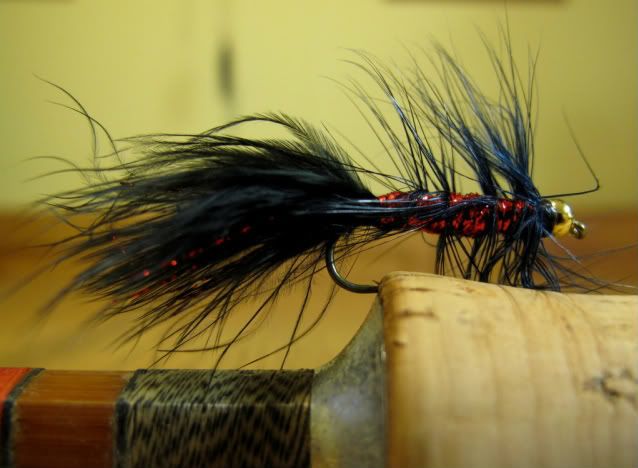
Lite Brite Biot Nymph
Biot Bug Nymph
Hook: Tiemco 3761 or other nymph hook, size 12-16
Thread: Brown
Weight: Non-lead wire
Head: Silver bead
Rib: Fine silver wire
Body: Lite Brite Polar Blue dubbing (looks white with blue highlights)
Wing/tail: Brown or white biots
Thorax: Lite Brite Peacock dubbing
Hackle: Brown
Put bead onto hook, then start thread. Wind thread back to the hook bend, then wrap 10-12 wraps of non-lead wire onto the hook. I use 12 wraps, along with a slightly oversized bead for the head, because I want the fly to sink quickly. Anyway, slide the wire forward to the head of the fly and into the bead. Bring thread forward and give a few turns of thread over the wire to hold it in place. Bring thread back to the hook bend.
Attach 3-4” of wire for rib. Use a very fine wire—I have tried with a “small” wire and the wire over powered the dubbing, giving a poor looking fly. After attaching wire, dub a small amout of the polar blue Lite Brite onto the thread. Lite Brite does not dub well—it is slippery—so work with small amounts and really twist well onto the thread. Tightly wrap dubbing forward, building a nicely tapered body, stopping about 1/3 back from the hook eye.
Take two brown biots, goose or turkey doesn’t matter but mine are goose (I think they are finer/thinner than turkey biots and that is good). Hold the biots over the back of the fly with a slight “V” shape, then tie down at the point you stopped the dubbed body. Try to keep the biots in a “V” and do not let them roll to the far side of the hook. 3 or 4 turns of thread should secure the biots well. Trim excess biot.
This is a tricky part: hold the biots down onto the back of the fly, then take ribbing wire and wind it forward over the biots, securing the biots to the fly. Wrap 4 or 5 turns of wire over the biots, evenly spacing the wraps to give a nice segmented body. Tie off the wire at the point where you tied in the biots and secure the wire with 4 or 5 wraps of thread. I like to add a drop of cement to the wire tie off point to really hold the wire in place.
Dub a small amount of Peacock Lite Brite onto the thread and build up a fuzzy thorax, maybe 2 or 3 wraps. Tie in a brown hackle just in front of the thorax. This can be a soft hackle, but finding good small (size 14 and 16) soft hackle can be difficult, so I now use lower quality brown dry fly hackle. It has a low barb count and isn’t really stiff so it works well for this fly. Give the hackle one or two turns then tie off. Avoid the practice of too much hackle—there only need be a few “legs” on this fly so 1 or 2 wraps is sufficient. Whip finish and you are done.




